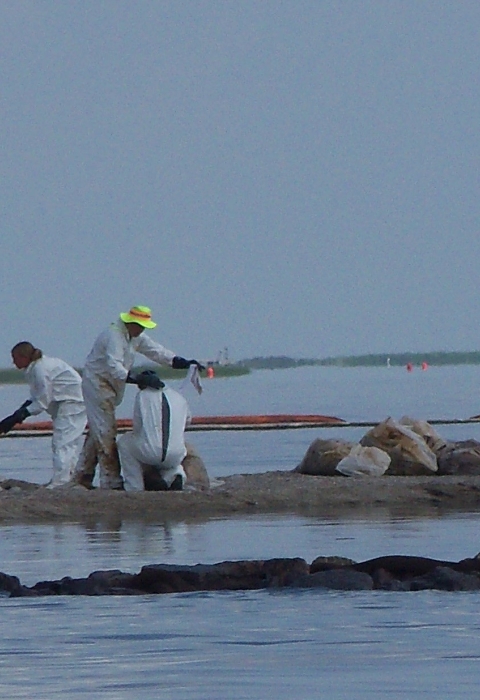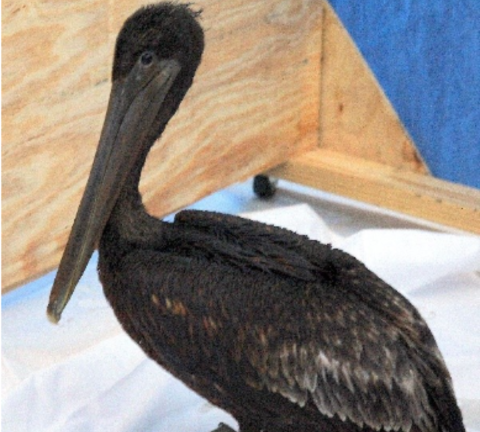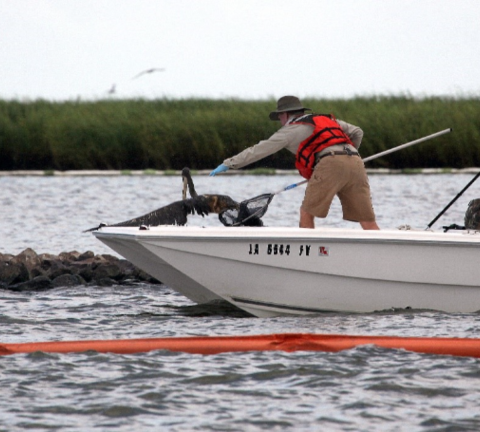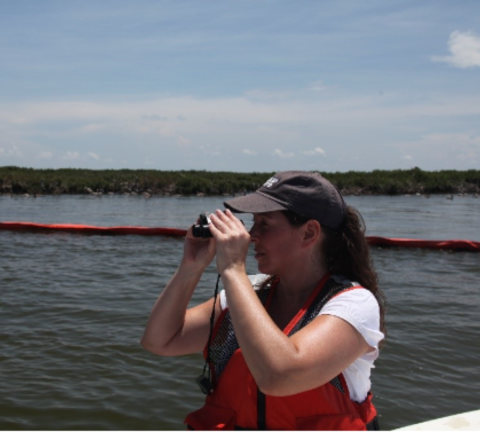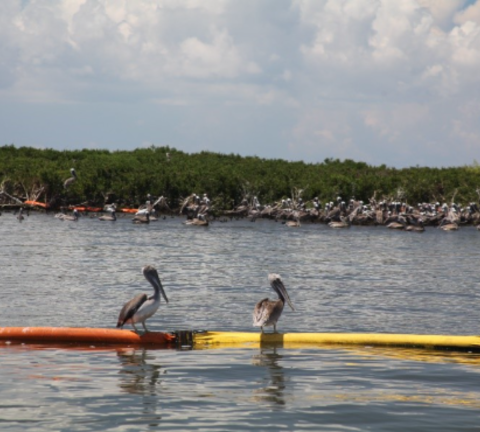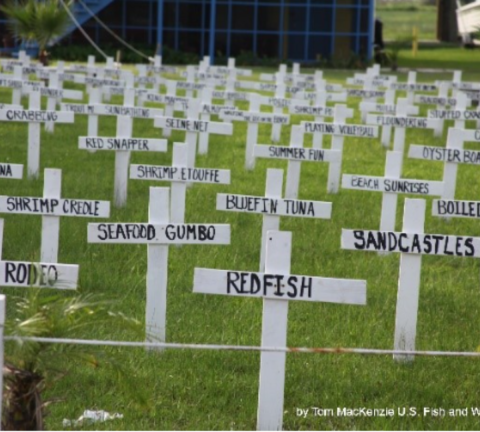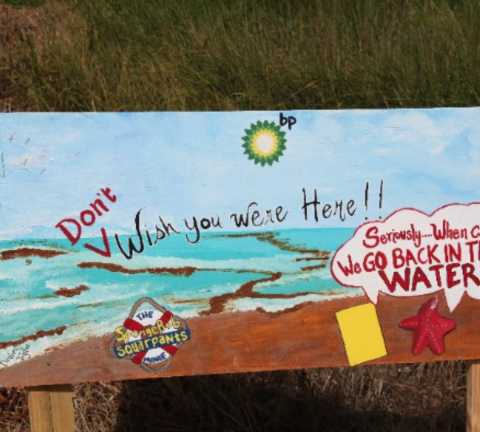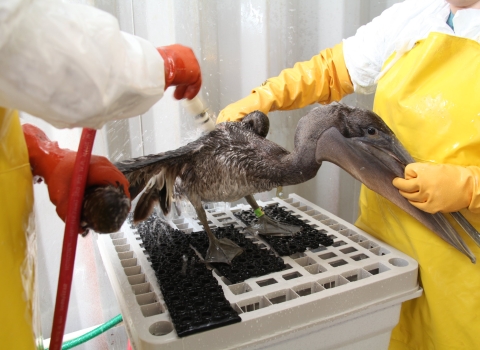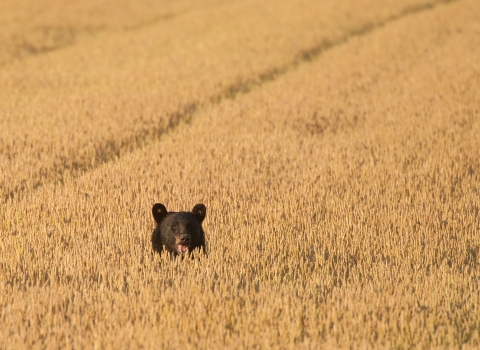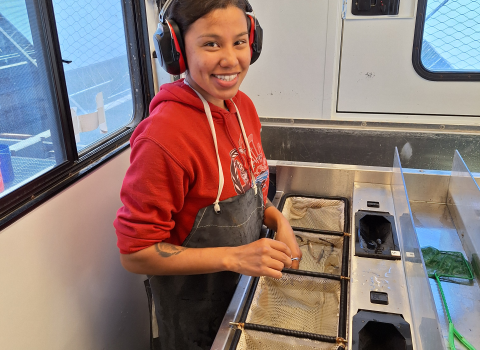Thirteen years ago, the Deepwater Horizon oil rig off the coast of Louisiana exploded. Images of the fiery explosion and oiled wildlife were plastered across television screens and newspapers as 134 million gallons of oil spilled into the ocean. Even after coverage of the spill lessened, many Service employees were deployed to the Gulf of Mexico to deal with the aftermath of one of the most damaging oil spills in the United States.
At the time, I was 11 years old. I watched as countless responders rescued pelicans, sea turtles, and other fish and wildlife covered in oil and wanted to be just like them (I had no idea that many of them would become my future colleagues). More than a decade later, I am now a Gulf Restoration Public Affairs Specialist with the U.S. Fish and Wildlife Service. Every day I get to share stories about how the Service continues working to restore the Gulf of Mexico (and the populations of fish, wildlife and plants that call the Gulf home or a feeding stopover during winter and spring migrations) after one of the most devastating environmental disasters in modern history.
This series features firsthand accounts of Service employees who were on the ground (or the water) in the Gulf during the immediate aftermath of Deepwater Horizon. Without knowing their names, I looked up to all of them as a young, future conservationist. Today, I am honored to work alongside these amazing people and help share their stories.
Below you can read our first account from Public Affairs Specialist Vanessa Kauffman. Vanessa served as the Chief Information Officer and helped search for injured wildlife during her deployment.
Vanessa Kauffman, Public Affairs Specialist
June 2010
It is 0400 and I am rising to get dressed on a hot day in Houma, Louisiana. I am living in a motel room in a town whose population is normally just over 30,000. Now, many thousands more people added in every living space to capacity. I have answered a call for help, and I am here to manage communications for the Deepwater Horizon Oil Spill. Each morning, I get up and drive about 15 minutes just outside of town passing canals and mangroves to an open stretch of road, arriving at an enormous facility perhaps several football fields long. This former BP offshore oil production training facility is now the main operations for the spill’s Joint Information Command, which is led by the U. S. Coast Guard. I show my badge for entry and park, sometimes walking in the over 100 degrees heat a quarter mile or taking a shuttle if it happens by to the guarded entrance. State, local and federal enforcement are stationed there to keep an eye out for press and others looking to enter the facility. Other sites like Mobile, Alabama; Miami, Florida; and Houston, Texas, have command posts, but our command post is the one with multiple press sitting outside, asking for access to tour a cavernous room that has been dubbed the fishbowl. It is the auditorium that the Coast Guard has converted into command central filled with computers, maps and live feeds across all walls of the whole operation. This includes live video of the oil coming out of the wellhead that is not yet capped.
I am a chief of the group of communications professionals sitting in a small room manned by over 20 men and woman from a variety of state and federal agencies. Only the Coast Guard is in uniform for their agency. The rest of us wear color-coded vests with our occupations on the back, but no one knows my agency or name unless they ask. My vest solely identifies me as a Public Information Officer (PIO). Part of my role each day is to meet with key teams to obtain updates on fish, wildlife and habitat that can shared via press conferences or news releases. For the first time, my agency has also been given the go to post about the impacts of this massive oil spill on social media.
I walk within the facility many thousands of steps each day, my office is on one end and most of the experts I meet with are on the other side. I must quietly and quickly walk through the fishbowl so as not to disturb the Coast Guard staff hard at work.
Our team is lucky to be inside, while hundreds of others are housed in large motorhomes complete with satellite dishes and generators out in the parking lot as there is no more room in the training facility – every single nook and cranny is occupied.
BP operates its cafeteria 24/7 to provide southern-style meals for everyone working around the clock. The food is actually quite good and only one way the facility supports responders. Stress therapy and even massages are offered, but I never have the chance to partake. When I finally have a day off, I head to the local mall to buy lightweight clothing since my PIO vest is the only uniform I need. Our vests show we are all on the same team, and as we build that team, we start trading our pins for others. We decorate the front of our vests with pins from partner agencies and nonprofits. I come home with quite a few.
Each morning, I attend the Coast Guard’s sunrise briefing in the fishbowl. Then, I head outside in the heat to a trailer to meet with the helicopter and aircraft surveillance operators, many of whom are retired or active wildfire pilots. They fly over the Gulf of Mexico reporting on the oil slick, oiled or dead wildlife and boom placements. Their reports are quite grim. The pilots work with the Service and partners to search for affected birds and lead wildlife rescuers to their locations. The helicopters fly low along the coastline to help biologists locate oil-covered birds and other wildlife.
Several times a day I meet in these trailers with partners from the International Bird Rescue Research Center, NOAA Fisheries, Smithsonian National Zoo, USGS and other biological and veterinary staff. We hold calls with our colleagues back in Washington, DC, and discuss details about oiled birds, sea turtles and other species that are being found and rehabilitated at the Fort Jackson Wildlife Rehabilitation Center in Buras, Louisiana. Each day we hope rehabilitated wildlife can be released and we can share that good news with the public.
I get a chance to share this good news a few times. Each day is long and tiring, often I am not home until 2200.
One day, I travel down to Grand Isle with a Service colleague. We are told to avoid any logos on our car – a white Ford bronco – that identifies us as government officials. When we enter the town, protest signs clearly state how unwelcome we are there with cartoon imagery of the oil spill and how it has affected the people, beaches and wildlife. Yet, we are working with the shrimpers and oystermen who have been hired to take us and press in their small fishing boats out in the Gulf of Mexico for scouting and photographing oiled wildlife. We visit Queen Bess Island where a huge colony of formerly endangered brown pelicans flourished as well as nested along the coastline. It is over 115 degrees, we wear sunblock that feels like saran wrap, yet it works. The island and others nearby are now surrounded by massive orange and yellow containment booms to prevent oil from making landfall, yet the oil does make its way in creating large tar balls on the beaches. Afterwards, we visit a local grocery that sells tackle and eat some of the best oyster po’ boy sandwiches, from frozen stock that was caught prior to the spill.
When we get word a week later that a hurricane that is expected to make landfall, a good portion of the Joint Information Center moves operations, including me and others, to the Unified Command in New Orleans. The hurricane pauses operations in the Gulf of Mexico. The wildlife rehabilitation facility is moved north to Hammond, Louisiana, out of the hurricane evacuation zone. While in New Orleans, I take the time to interview some of the command officials and publish their stories online. One day, local Louisiana partners take us to areas of New Orleans still affected by Hurricane Katrina and visit a newly reopened bar and restaurant that also supports animal rescue. At the end of July, I take my leave even though the Coast Guard has asked me to extend my stay for another month. The lack of sleep from long hours and experiencing such extreme ups and downs is taking its toll.
April 2023
As I return home to the DC area, I think with hope how many of the rehabilitated birds were released back on Queen Bess Island and may be nesting along with many other colonial waterbird bird species, like terns, skimmers, tricolored herons, reddish egrets, roseate spoonbills, American oystercatchers, great egrets and snowy egrets. This experience gave me some incredible learned lessons in patience, crisis management, relationship building and most of all human compassion. And some colorful pins that help me remember those lessons.
-----------------------------------------------------------------------------------------------------------------
Stay tuned for more firsthand accounts from Service employees in our After the Spill: Deepwater Horizon series.
